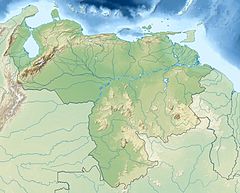| Anomaloglossus breweri | |
|---|---|

| |
| Female holotype | |
| Conservation status | |
 Near Threatened (IUCN 3.1) | |
| Scientific classification | |
| Domain: | Eukaryota |
| Kingdom: | Animalia |
| Phylum: | Chordata |
| Class: | Amphibia |
| Order: | Anura |
| Family: | Aromobatidae |
| Genus: | Anomaloglossus |
| Species: | A. breweri |
| Binomial name | |
| Anomaloglossus breweri (Barrio-Amorós [fr], 2006) | |
 | |
| A. breweri is only known from its type locality, Aprada-tepui in Venezuela | |
| Synonyms | |
|
Colostethus breweri Barrio-Amorós, 2006 | |
Anomaloglossus breweri is a species of frogs in the family Aromobatidae. It is only known from its type locality, Aprada-tepui in the Bolívar state of southeastern Venezuela. This species was discovered by scientists exploring the inaccessible and remote region of Aprada-tepui. It is a fast-moving frog that lives along creeks and in quiet pools along small streams along the slopes near the cave. The frog is named for Charles Brewer-Carías who collected the type series.
Description
The distinctive features of this species are its particular skin pattern, absence of fringes on fingers, moderate toe webbing, tongue characteristics, and yellow and orange coloration on its undersides. The type series consists of one female (the holotype), two males, and one unsexed juvenile. The female measures 24 mm (0.9 in) and the larger male 21 mm (0.8 in) in snout–vent length.
Habitat and conservation
Anomaloglossus breweri is only known from a collapsed steep gorge on the northwestern slope of the tepui at an elevation of 660 m (2,170 ft) above sea level. It is probably more widespread on the tepui, and perhaps in the surrounding areas. The specimens were found along creeks and in quiet pools along small streams.
Aprada-tepui is located within the boundaries of the Canaima National Park. This species could still be threatened because of its small range, making it sensitive to catastrophic events.
References
- ^ IUCN SSC Amphibian Specialist Group (2020). "Anomaloglossus breweri". IUCN Red List of Threatened Species. 2020: e.T136051A109544033. doi:10.2305/IUCN.UK.2020-3.RLTS.T136051A109544033.en. Retrieved 20 November 2021.
- ^ Barrio-Amorós, C. L. (January 17, 2006). "A new dendrobatid frog (Anura: Dendrobatidae: Colostethus) from Aprada tepui, southern Venezuela" (PDF). Zootaxa. 1110: 59–68.
- ^ Frost, Darrel R. (2020). "Anomaloglossus breweri (Barrio-Amorós, 2006)". Amphibian Species of the World: An Online Reference. Version 6.1. American Museum of Natural History. doi:10.5531/db.vz.0001. Retrieved 23 June 2020.
- Barrio-Amorós, C. L.; Rojas-Runjaic, F. J. M. & Señaris, J. C. (2019). "Catalogue of the amphibians of Venezuela: Illustrated and annotated species list, distribution, and conservation" (PDF). Amphibian and Reptile Conservation. 13 (Special Section): 1–198.
- ^ Bjorn Carey (February 21, 2006). "Explorers Discover Huge Cave and New Poison Frogs".
| Taxon identifiers | |
|---|---|
| Anomaloglossus breweri | |